ISSN 2738-862X
In 2004 Cambridge University Press published the book ‘The End of Art’[1] by the American art history professor Donald Kuspit which can be described as conservative, old-fashioned and elitist as far as it is fraught with open hostility towards the strategies of the neo-avant-garde art and postmodern art discourses. Actually Kuspit’s book is rather a book about the psychological end of art, the fall of the psychological art and psychological aspects in art at the expense of the social aspects.
According to Kuspit in postmodernism the artist loses the integrity of his alienation and art becomes an instrument of social integration and thus losing its aesthetic power. In the paradoxical social appropriation of art Kuspit sees an unconscious attempt for neutralization of the aesthetic potential of art.
In the part of the book with the most intense romantic pathos, which is entitled ‘The Decline of the Cult of the Unconscious’, Kuspit points out that modern art begins with the discovery of the unconscious, and then in the second half of the 20 century the postart[2] and the anti-aesthetic try to reduce unconscious to an ideology. The unconscious perceives the things in their unknown mystical essence, while the ideology uses the ‘objective’ non-magic nature of reality with the assumption that this objective nature can be controlled in reality.
According to Kuspit postart turns everything into a social spectacle, while in modern art with its cult of the unconscious, the external reality is not as exciting as the inner reality.
The main objective of modern artists is to exhibit and express their inner reality. For example, Kandinsky regards his art as a spiritual activity, and the Suprematist paintings of Malevich are as sacred icons. According to Kuspit Mondrian undergoes an agonizing transition from the external to the internal reality hoping that the sacred geometry will save him from his own internal reality. [3]
The most important thing in this case, according to Kuspit, is that to modern artists the inner reality has entirely different dynamics from the external reality, which arises a need for new creative methods and a new art form which is able to describe this inner reality. It is this new radical subjectivity and individuality that generate interest in originality, hypersensitivity and the supernatural.
For Kandinsky art is the last bastion of the spiritual against materialism as well for the most modern artists who have taken art as a spiritual religion.
Analyzing the theory and practice of Allan Kaprow who in his happenings tries to dismiss the fact that life has unconscious transcendental and aesthetic dimensions, Kuspit comments that postart not only tends to demystify art, but entirely turns its back to the spiritual aspects at the expense of its social and economic importance in the consumer society. It could be said that if modern art attempts to become a religion, postart is obsessed with the desire to become a social science.
According to Kuspit the most characteristic feature of postart is that it marks the end of the cult of the unconscious. Symptoms for this conclusion Kuspit sees in the fact that in modern art the regression to the psychotic and unconscious is in service of creativity, while in postmodern art that regression becomes an entertaining show and a game, and the function of this spectacle is constantly to keep us on the surface of our psyche.
Kuspit defines postart as ‘pseudo-unconscious' or ‘postunconscious’ and fully adheres to the romantic idea of modern art and its heroic psychological subject, opposing it to the weak and cynical subject in postmodernism.
It is not a coincidence that in his book Kuspit subjects to criticism Marcel Duchamp and Andy Warhol who resurrect the deprived of emotions and existential depth infantile subject of Dadaism. [4]
On his side, the American art critic Hal Foster consideres the neo-avant-garde use of the Dadaist nihilism in the second half of the 20 century as a strategy which aims to present a panic subject behind the figures of the missing subjectivity. [5]
Foster shows that in Pop art and Minimalism the absence of psychological parameters is only ostensible. He argues, based on the Lacan’s ideas, that Pop art refers to Surrealism as traumatic realism.
Also according to him the art of Minimalism re-introduces the psychological interest in the body, but not in the form of an anthropomorphic image or by suggesting one illusory space of the mind, but by the mere presence of objects, which causes new interest in perception and new interest in the subject.
According to Foster Minimalism plays a key role in the genealogy of art from the 1960's until today with its dialectical participation in both the neo-avant-garde art and postmodern practices of late modernism.
At the same time Minimalism includes psychological model of art, which is based on the phenomenological psychology, which offers no criticism of the subject. This is the circumstance in which Foster sees the historical and ideological boundaries of Minimalism.
Regarding the development of contemporary art Foster argues that the repressed reality of poststructural postmodernism returns as the traumatic. The dissatisfaction of the textualist model of culture, and also from the conventional view on reality gives rise to interest in the traumatic subject in art.
In the late 20th century the poststructural criticism of the subject is related to the cultural policy of the different subjectivities and if the author is the great protagonist in modernism, the institutions and the public are the major protagonists in postmodernism.
The ignored subjectivism raises tension in the postpsychological models of art which are rhetorical and are imposed most often through the figures of absence and non-presentation.
Foster displays two main trends in the development of art in the 1990's, one of which refers to the problematization of the body as a psychological terrain associated with the strategies of ‘abject’, and the other – with the new dimensions of the social, updated by the ‘site-specific‘. Both trends are most clearly manifested in the development of the installation as an art form that is now not so much about arranging objects, but about combining different activities.
Up to present day, more and more researchers engage with the idea that namely the installationism is the dominant form of art in the late 20 and early 21 century.
In the introduction to his book ‘Deconstructing Installation Art’[6] the British art historian Graham Coulter-Smith says that in the 1990’s installation goes ahead as a leading trend in postmodern art, replacing the previously dominant style of postmodern ‘appropriation’.
As a reason for this development Coulter-Smith sees the three fundamental characteristics that the art of installation includes: 1) striving to create a more direct interaction between the spectator and the work of art; 2) the specific feature of the installation to present fragments to the viewer, which must be studied and arranged in a manner which ‘activates’ him; 3) developing a strategy, which deconstructs the traditional concepts of art work.
Coulter-Smith relates the above-stated three characteristics to the three major artistic discourses in the first half of the 20th century, namely, expressionism, abstraction and the transgressive aesthetics of Duchamp, Dada and Surrealism. Exactly the neo-avant-garde practices associated primarily with the third discourse turn into the basis of the modern art of installation. Coulter-Smith offers as a summary term for this third discourse the term ‘deconstructive art.’ [7] According to him the first generation of deconstructive art involves the transgressive aesthetics of Duchamp, Dada and Surrealism, which in the 1960’s is further developed by the New Realism, Fluxus, Pop art, Minimalism, Arte Povera, Land art, Performance and Conceptual art. The third generation of deconstructive art appears in the late 1970's and early 1980's with the different postmodern techniques of appropriation. The current domination by the deconstructive art as an international style according to Coulter-Smith changes the very definition of deconstruction, displacing it from the forms of transgression to the forms of the game.
As long as Coulter-Smith seeks ideological explanation and a certain formal logic in the development and establishment of installationism as a leading art trend in contemporary art, the book by the British researcher Claire Bishop ‘Installation Art: A Critical History’[8] offers an insight into the history of installationism which is not based only on the ideas, methods and forms, but mainly on the psychological experiences of the viewer.
Bishop organizes her book around four psychological models that structure the experience of the viewer. Each of these four models suggests a different type of subject, which in turn provokes a different kind of art.
The first part of the book which is entitled ‘The Dream Scene’ presents the classic psychoanalytical model inspired by the theories of Sigmund Freud, which are fundamental to Surrealism. The International Surrealism Exhibition in 1938 has a paradigmatic role in the development of this type of installations which attempt to immerse the viewer in a psychologically absorbing, dream-like environment. The second part of the book entitled ‘Heightened Perception’ examines the impact of the phenomenological psychology in 1960’s on Minimalist art and the type of installation art which it generates. The third part, which is called ‘Mimetic Engulfment’, discusses the influence of structural psychoanalysis and psychological models of subjective disintegration on the development of installationism in the 1970's and 1980's. The fourth part of the book which is titled ‘Activated Spectatorship’ examines the contemporary forms of installation and the place of the viewer as a political subject in the context of the critical theory. Namely the fourth model, which attempts to activate the viewer as a political subject is the most controversial in terms of existing theoretical models of interpretation. [9]
Bishop’s book, which is extremely interesting with its research methodology, shows that in the early 21 century the art history can successfully use psychological approaches to art, both as an explanatory context, and polemical rhetoric.
There is no doubt that certain kind of psychological approaches to art can be found in art forms and art theories that avoid or openly reject any psychological horizon as an object of analysis. For example the question of most postpsychological rhetoric is whether art discourse with no subject psychology is possible. This issue, however, quite logically causes psychological interest in everything that calls for a ‘psychological’ exclusion of the subject from the field of art.
In the last fourth part of his book ‘Postproduction’ Nicolas Bourriaud offers a purely sociological explanation of how art in the 1960's, from Pop art and Minimalism to Conceptual art, is connected with the rise of industrial production and mass consumption. [10] The materials preferred by the minimalist artists such as anodized aluminum, galvanized iron, neon and Plexiglas, redirect to the industrial technology of giant factories and warehouses. The iconography of Pop art responds to the emergence of the supermarket and the new forms of marketing, based on visual frontality, seriality and abundance. According to Bourriaud the ‘contractual’ and ‘administrative’ aesthetic of Conceptual art marks the beginning of the service economy. Conceptual art Introduces the idea of art as a database through artistic practices that use the dry and boring forms to classify information using index cards and computer records.
To the conceptual work of art the physical presence does not matter, since the primary role is the formula itself, not the place and the way it is materialized, nor the identity of the person who is related to its implementation.
What distinguishes conceptual art from all previous forms of art is that it reaches the ‘dematerialization’ of the artistic object. In this way, Conceptual art suggests maximum psychological distance between the artist and the art works.
The pursuit of Conceptual art is connected with the creation of entirely non-sensorial and seemingly non-aesthetic model of art in which the psychological presence of the subject seems to be reduced to zero.
Conceptual works such as the installation of the American artist Joseph Kosuth called ‘Any two square meters sheet of glass to lean against any wall’ from 1965 should exclude any subjective reaction, as the conceptual procedure itself suggests a situation which is stripped of irrational suggestions, completely predictable and psychologically ‘sterile’.
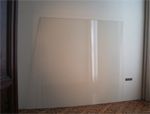 Joseph Kosuth, Any two square meters sheet of glass to lean against any wall, 1965. Exhibition ‘Glass Stress’, Palazzo Cavalli Franchetti, Collateral Event of the 53rd Venice Biennale, 2009.
Joseph Kosuth, Any two square meters sheet of glass to lean against any wall, 1965. Exhibition ‘Glass Stress’, Palazzo Cavalli Franchetti, Collateral Event of the 53rd Venice Biennale, 2009.
However, Kosuth’s work is filled with so much vacuum that from a psychological point of view it is really shocking in the way in which it faces the viewer with its transparent and meaningless nature. It could be speculated that this overrational striving to absolute control and elimination contains certain unconscious injury of the subject in itself. The remaining psychological stress in the Kosuth’s work can be attributed to the physical presence of the subject and its direct pure phenomenological - in the context of minimalism - admission into the work space.
It is a paradox that at the same time in mid-1960's, namely when the apogee of the classical analytical conceptualism begins, in complete secrecy Marcel Duchamp prepares the psychological return of the unconscious in art.
In 1966 Duchamp completes his last major work ‘Étant donnés’, which portends the future hegemony of the art of installation.
 Marcel Duchamp, Étant donnés, 1944-1966.
Marcel Duchamp, Étant donnés, 1944-1966.
The latest installation of Duchamp and its accompanying institutionality[11] and personal mystery[12] are a legacy that can be read as a prophecy that art has always been and will remain a mysterious place for psychological habitation. [13]
In the institutional context of neo-avant-garde the installation gradually manages to become the most immersive and expanded form of art.
Thus, the installation ends the disciplinary tensions related to the parameters and hierarchy of the different types and genres within art.
There is no doubt that the future of the installation is that of an originating media. This is the reason why some authors conclude that the current installation is not connected as much with deconstruction as with the construction and assemblage, which relate to the processes of accumulation and intensification. [14]
The American art critic Anne Ellegood thinks that in contrast to the formulas and systems of conceptual art, which support ‘practices that engage in improvisations and tap into the unconscious’, the contemporary art of installation is ‘remarkably expressive’ and rather emotional
than reductive. [15]
Several major directions in which contemporary installation experimented using its psychological potential can be outlined.
The first line of development that in recent years has been exposed under the label ‘baroque sensibility’ is intended to provoke a strong psychological reaction that stimulates our senses in an openly physiological manner. Authors such as the Canadian David Altmejd and the Belgian artist Berlinde De Bruyckere rely on the direct reaction that certain forms and materials cause on a purely instinctive level.
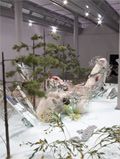 David Altmejd, The Holes, 2008. Installation in the Wolfson Room at Tate Liverpool. Part of MADE UP, the Liverpool Biennial International 2008 Exhibition.
David Altmejd, The Holes, 2008. Installation in the Wolfson Room at Tate Liverpool. Part of MADE UP, the Liverpool Biennial International 2008 Exhibition.
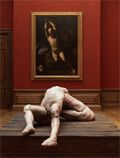 Berlinde De Bruyckere, We are all Flesh, 2009. Installation, inspired by the paintings of Baroque Neapolitan artist Luca Giordano (1634-1705). Gallery Hauser & Wirth, London.
Berlinde De Bruyckere, We are all Flesh, 2009. Installation, inspired by the paintings of Baroque Neapolitan artist Luca Giordano (1634-1705). Gallery Hauser & Wirth, London.
The second line of development is Postminimalistic and the strategies, connected to it, for activating viewer’s reactions can be related to the psychology of the external space. Authors such as the Swiss artist Urs Fischer and the German Felix Schramm literally destroy from the inside ceilings, floors and walls of the museum halls and spaces and place in a whole new ‘catastrophic’ dimension the Minimalist art and its physical relation to the body.
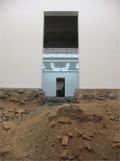 Urs Fischer, You, 2007. Site-specific installation at Gavin Brown’s Enterprise, New York.
Urs Fischer, You, 2007. Site-specific installation at Gavin Brown’s Enterprise, New York.
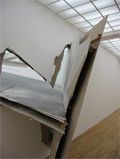 Felix Schramm, Missit, 2006. Site-specific installation at Hamburger Bahnhof Museum, Berlin.
Felix Schramm, Missit, 2006. Site-specific installation at Hamburger Bahnhof Museum, Berlin.
The third line examines the field of psychological identities through the desire for interaction. The originality of the so-called ‘performance-installations’ is in their ability to involve the viewer in the work and turn him into a major player and character. Artists like the Argentine Rirkrit Tiravanija and the Spanish artist Santiago Sierra create installations, designed as psycho-social experiments in which the viewer is directly involved through his ability to identify psychologicaly, whether he is invited to be part of a friendly dinner or is just a silent witness to scenes of ‘economic exploitation’, which humiliate human dignity.
 Rirkrit Tiravanija, Untitled (Free),1992. David Zwirner Gallery, New York, 2007.
Rirkrit Tiravanija, Untitled (Free),1992. David Zwirner Gallery, New York, 2007.
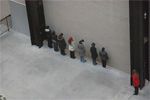 Santiago Sierra, Group of persons facing the wall (homeless women payed the price of a one night stay in a hostel to stand facing the wall of the gallery for one day), Tate Modern, London, 2008
Santiago Sierra, Group of persons facing the wall (homeless women payed the price of a one night stay in a hostel to stand facing the wall of the gallery for one day), Tate Modern, London, 2008
The fourth line of development is related to an interest in wide range of psychological phenomena strongly avoided by Minimalism and Conceptual art. Without being directly linked to psychoanalysis, as Surrealism, this fourth model uses the territory of the strange and unusual, erasing the boundary between the scientific attitude towards paranormal phenomena and the eclectic ethnographic empathy to superstitions, illusions and spiritual attitudes.
Authors such as the American Peter Coffin and the New Zealand artist Francis Upritchard create installations that try to resurrect not so much the ‘cult of the unconscious’ but the ‘aura of the invisible psychic presence’ through a strange mixture of curiosity and skepticism about the contemporary ‘psychological slips’ of the supernatural.
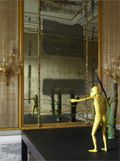 Francis Upritchard, Save Yourself, 2009. Fondazione Claudio Buziol, Palazzo Mangilli-Valmarana, Official participation of New Zealand at the 53rd Venice Biennale, 2009.
Francis Upritchard, Save Yourself, 2009. Fondazione Claudio Buziol, Palazzo Mangilli-Valmarana, Official participation of New Zealand at the 53rd Venice Biennale, 2009.
The art of contemporary installation can be openly defined as psychological media. It is not exaggerated to say that the new function of this media is definitely not to reduce or eliminate the psychological aspects of art, but rather to revive interest in them and in the various contemporary forms of psychological art.
---
[1] Kuspit, D. The End of Art. Cambridge: Cambridge University Press, 2004.
[2] The term 'postart' is coined by American artist Allan Kaprow as an attempt to describe the situation in which contemporary art becomes a commentary on the boundary between art and life (Kaprow, A. Essays on the Blurring of Art and Life. Berkeley: University of California Press, 1993). Kuspit interprets postart as a category which rises the trivial at the expense of the enigmatic, the scatological at the expense of the sacred and wit at the expense of originality. According to Kuspit postart is a completely banal art that is neither kitsch nor high art, but an in-between art that glamorizes everyday reality pretending to analyze it '(Kuspit, 2004, 91).
[5] Foster, H. The Return of the Real. The Avant-Garde at the End of the Century. Cambridge, Mass.: MIT Press, 1996.
[6] Coulter-Smith, G. Deconstructing Installation Art. CASIAD Publishing, 2006.
[7] In the 1980s art theorists experimented with terms such as the ‘antiaesthetic’ (Foster 1983) and ‘transgressive art’, but these labels never attained the generic scope of the terms ‘abstraction’ and ‘expressionism’, similarly even the promising term ‘postmodern art’ that dominated discussions of art during the 1980s gave way at the turn of the millennium to a somewhat feeble recourse to the now historical term ‘conceptual art’ (Coulter-Smith, 2006).
[8] Bishop, C. Installation Art: A Critical History. London: Tate Publising, 2005.
[9] One of the most influential models of interpretation, which tries to explain the active participation of the audience in the development of contemporary art is connected with the name of the French theorist Nicolas Bourriaud and his 'relational aesthetics', which deals with art as a reality of human interactions in social contexts (see Bourriaud, N. Postproduction. New York: Lukas & Sternberg, 2002 and Bourriaud, N. Relational Aesthetics. Paris: Presses du reel, 2002). Bourriaud proposes a theoretical model in which the museum art of 'autonomous symbolic space' is opposed to 'art as a laboratory for human contact', the completed art object is opposed to the ‘project-based work-in-progress’, the art as a market product is opposed to the art as a marketing service. Bishop in turn sees in the subject of relational art an identity protected from social antagonism, which is rather a product of inner institutional experiments with the existing exhibition conventions than a real political subjectivity (Bishop, C. Antagonism and Relational Aesthetics, October, 110 2004).
[10] Bourriaud, N. Postproduction, 2002, 85-86.
[11] It turns out that Étant donnés is part of an invisible network of sophisticated legal and institutional relations. The secret sale of the work is done as early as the mid 1960's and its owner becomes a trusted friend of Duchamp, William Copley and his Cassandra Foundation, who are responsible immediately after the death of Duchamp to donate the work to Philadelphia Museum of Art. To make this possible, Duchamp developed a manual with clear instructions for its installation and instructions on when and how the work can be photographed. So in 1969, literally from the grave Duchamp continues to 'curate' the exhibition of his last work. The contract between the Cassandra Foundation and Philadelphia Museum of Art, noted that for a period of fifteen years any copying or reproduction of the work is prohibited except for the door behind which the installation is. Thus, more than fifteen years Étant donnés does not exist as an image, which demonstrates Duchamp's intention to preserve for as long as possible the existence of Étant donnés primarily as an experience.
[12] It remains a mystery how Duchamp managed to keep Étant donnés a secret from his family and friends provided he has worked on this installation for more than twenty years. Later it becomes apparent that for his secret installation Duchamp hired a second studio; in the first official studio he welcomes visitors and friends, plays chess and gives interviews in which he claims that everything he does is to do nothing but meanwhile in the second secret studio he eventually pursues, in the words of Donald Kuspit the 'unexpected return of his repressed sexuality' (see Kuspit, 2004, 46-47).
[13] According to Craig Adcock in Étant donnés there is no exterior, ‘It has only interior from which you look at another interior.‘ (See Adcock, C. Duchamp’s Way. In: Definitively Unfinished Marcel Duchamp, ed. Thierry de Duve, Cambridge, MA.: MIT Press, 1991, 342). Habitation of the interior in art is associated with various forms of psychological 'admission' of the body. In this sense, the inner space is infinite emotional territory with psychological potential. (See Tzanev, P. Psychology of Art. Sofia: National Academy of Art, 2008, 433).
[14] Ellegood, A. Motley Efforts. Sculpture’s Ever-Expanding Field. In: Vitamin 3-D: New Perspectives in Sculpture and Installation. London: Phaidon Press, 2009
